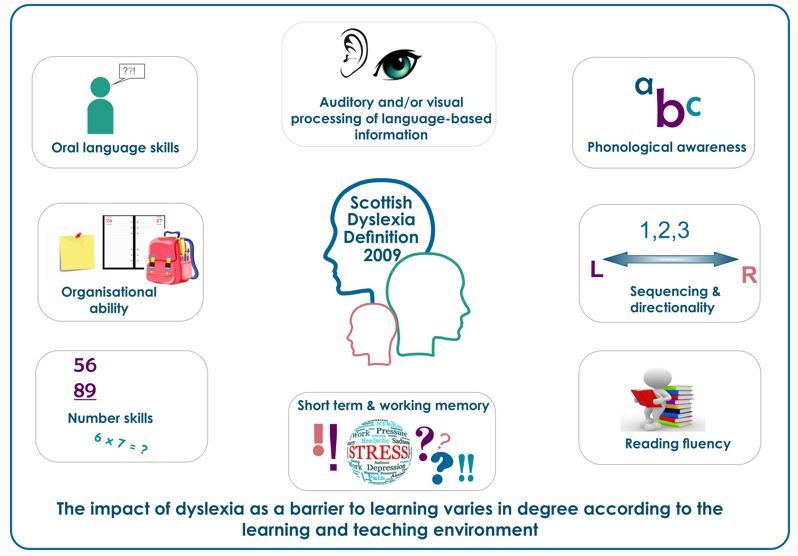What is Dyslexia?
The Scottish definition of dyslexia has been developed by the Scottish Government, Dyslexia Scotland, the Cross Party Group on Dyslexia in the Scottish Parliament and a wide range of stakeholders. This is one of many definitions available and is recommended as helpful guidance by Education Scotland.
The aim of this particular working definition is to provide a description of the range of indicators and characteristics of dyslexia as helpful guidance for educational practitioners, children, parents/carers and others.
This short video on the Scottish Definition of Dyslexia gives some real-life examples from children and young people about what it means for them:
Scottish Definition of Dyslexia
Dyslexia can be described as a continuum of difficulties in learning to read, write and/or spell, which persist despite the provision of appropriate learning opportunities. These difficulties often do not reflect an individual’s cognitive abilities and may not be typical of performance in other areas.
The impact of dyslexia as a barrier to learning varies in degree according to the learning and teaching environment, as there are often associated difficulties such as:
- auditory and/or visual processing of language-based information
- phonological awareness
- oral language skills and reading fluency
- short-term and working memory
- sequencing and directionality
- number skills
- organisational ability
Motor skills and co-ordination may also be affected.
Dyslexia exists in all cultures and across the range of abilities and socio-economic backgrounds.
It is a hereditary, life-long, neurodevelopmental condition. Unidentified, dyslexia is likely to result in low self-esteem, high stress, atypical behaviour, and low achievement.
Learners with dyslexia will benefit from early identification, appropriate intervention and targeted effective teaching, enabling them to become successful learners, confident individuals, effective contributors and responsible citizens.

At all stages, dyslexia is on a continuum varying from mild to severe, with a range of strengths and difficulties and, according to the nature of the activity undertaken, the learning environment and any coping strategies and support in place. As a result, every individual with dyslexia will differ in the range of factors that are affected and in the level of severity experienced. There is however a common set of signs that can be observed.
Receiving appropriate additional support when required is not dependent upon the formal identification of a specific label such as dyslexia. However, this should not be interpreted to indicate that schools and local authorities are not supportive of formally identifying additional support needs such as dyslexia. Indeed the information gathered during the identification process is valued and forms part of the ongoing monitoring of the child or young person’s progress and support.
Reading Materials
Dyslexia Scotland have produced a range of leaflets designed to support pupils, parents/carers, and school staff. These not only provide helpful information on dyslexia but also outline a range of support strategies:
Dyslexia Checklist & Indicators
Explaining Dyslexia to Children

Films About Dyslexia
The following selection of short films may help you to understand what it feel like to be dyslexic and to explain this to pupils, parents and colleagues.
Dyslexia Scotland Animation – Young People’s Guide to a Growth Mindset:
Calum’s Film
Free Online Learning Modules
Three free online learning modules have been developed in response to Recommendations 1 and 2 of the 2014 Education Scotland Review: Making Sense of Dyslexia: Education for Children and Young People with Dyslexia in Scotland. The aims of these modules are:
- to inform practitioners about ways in which they might engage in meaningful career-long professional learning in order to improve outcomes for children and young people;
- to provide free and accessible opportunities to engage with professional learning;
- to support deeper learning and understanding of dyslexia and inclusive practice;
- to provide opportunities for participants to reflect on their practice regarding dyslexia and inclusion and
- to encourage all practitioners to be familiar with, and make appropriate use of, the Addressing Dyslexia Toolkit.
The modules are:
- Module 1: ‘Introduction to Dyslexia and Inclusive Practice’
- Module 2: ‘Supporting Dyslexia, Inclusive Practice and Literacy’
- Module 3: ‘Dyslexia: Identification and Support’
All of the modules need to be completed in order – you cannot go straight to module 2 or 3 without doing the previous one. Please note that you need to log into OpenLearn Create before you start the modules.
Click here to access Module 1 ‘Introduction to Dyslexia and Inclusive Practice’
Click here to access Module 2 ‘Supporting Dyslexia, Inclusive Practice and Literacy’
Click here to access Module 3 ‘Dyslexia: Identification and Support’
The modules are hosted on the Open University OpenLearn Create platform. Mozilla Open Badges will be available for those completing the modules.
Useful Websites
Dyslexia Scotland
https://www.dyslexiascotland.org.uk/
Addressing Dyslexia Toolkit
http://addressingdyslexia.org/


